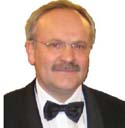Keynote Speaker---Prof. Sigitas Tamulevičius

Member of the European Materials Research Society, Professor of the Physics Department, Kaunas University of Technology (KTU), Republic of Lithuania
Biography: Prof. Dr. Habil. Sigitas Tamulevičius, obtained his Physics Engineer degree from the Moscow Engineering Institute in Physics (Moscow, former USSR) in 1979, a Ph.D. degree from the University of Vilnius (Lithuania) in 1984, Doctor Habilitus degree from Kaunas University of Technology (1994). From 1990 to 1991, he was a postdoc at Royal Institute of Technology (Stockholm, Sweden). In 1994 he was Research Scholar, Fulbright Scholarship, Department of Physics, Massachusetts Institute of Technology (USA). Since 1996 he is full professor at the Physics Department and Research director of the Institute of Materials Science of Kaunas University of Technology (Lithuania). He has co-founded spin-off company producing optical security means, co-authored approx. 220 peer reviewed publications indexed in Web of Science (WS) in the field of vacuum and plasma technologies and optical microstructures with more than 1200 citations (h-index: 18), and is (co-) author of approx. 15 textbooks on different aspects of Materials Science. From 2002 he was Member expert and from 2010 he is full Member of Lithuanian Academy of Sciences. Prof. Tamulevičius has received series of awards including Soros Foundation Research Grant, (1993) (Awarded by American Physical Society), Fulbright certificate (1997), National Award for Science (2000), Recognition letter by the President of EMRS (2010), Kaunas city Best scientist award (2017). He was awarded Adjunct professor in Materials Science at Southern Denmark University (2016). He is Editor in Chief of Scientific Journal “Materials Science (Medžiagotyra)" (WS, Clarivate Analytics) , Member of Editorial Board of “Materials Research express” (IOPScience). He was a national representative in FP7 NMP programme. He headed multiple research projects funded by European Framework Program, COST, Eureka, NordForsk, Lithuanian State Foundation for Research and Studies, the Research Council, as well as Science and Innovation Agency of Lithuania.
Speech Title: Plasmonic properties of metallic nanoparticles in colloidal solutions and 2-D ordered systems
Abstract: The optical properties metals such as gold (Au), silver (Ag) and copper (Cu) are interesting because they support collective excitations of free electrons called surface plasmons (SPs). SPs generate strong electromagnetic (EM) fields that enable various electro-optical applications in molecular sensing, medical therapy, solar cells, photodetectors, surface-enhanced Raman spectroscopy substrates, ultrafast optical switches, opto-mechanical devices, photocatalysis, nano-antennas and metamaterials [1].
In our research we present optical and opto- mechanical properties of Ag nanocubes (NCs) and Au bipyramids (BPs) synthesized using colloidal chemistry methods. We expand range of the available plasmonic properties to the UV region using Al NPs and compare them with corresponding properties of the noble metallic ananoparticles. We have observed transient absorption spectroscopy (TAS) signal relaxation in Ag NCs and Au BPs that we can attribute to electron-phonon coupling ant phonon-phonon scattering. Highly homogeneous Ag NCs [2] and Au BPs have showed clear optomechanical oscillations while Al NPs have not showed any clear oscillations.
Plasmonic metal nanoparticles arranged in a periodic array can generate a surface lattice plasmon resonance with an extremely high Q-factor. We used the capillary force assisted particle assembly technique [3] to assemble nearly defect-free >1 cm2 hexagonal lattices of wet-synthesized Ag cuboctahedra with edge lengths of 123 ± 2 nm and a center-to-center spacing of 600 nm. These arrays are large enough to be measured with conventional UV-Vis spectroscopy, which revealed a surface lattice resonance extinction peak with a quality factor 28.6 at orthogonal illumination and up to 62.1 at higher illumination angles. Analysis of the plasmonic modes showed the possibility of the nanoparticles in our arrays to be excited into both in-plane and out-of-plane surface lattice resonance states. The combination of the combination of high aspect ratios of the particles and precise patterning allows us to achieve the highest Q-factors even at normal incidence and an asymmetric environment. The ease of generating ultra-narrow resonances that are still accessible to the surrounding environment should make applications such as nanolasing and biosensing a lot easier.
Keywords: nanoparticles, plasmonics, optical properties
[1] S. Tamulevičius, Š. Meškinis; T. Tamulevičius, H.-G. Rubahn,. Diamond like carbon nanocomposites with embedded metallic nanoparticles // Reports on Progress in Physics. 2018, Vol. 81, iss. 2, art. 024501, p. 1-31. DOI: 10.1088/1361-6633/aa966f.
[2] D. Peckus, H. Rong, L. Stankevičius, M. Juodėnas, S. Tamulevičius, T. Tamulevičius, J. Henzie, Hot electron emission can lead to damping of optomechanical modes in core−shell Ag@TiO2 nanocubes // Journal of Physical Chemistry C. 2017, vol. 121, iss. 43, p. 24159-24167. DOI: 10.1021/acs.jpcc.7b06667
[3] D. Virganavičius, M. Juodėnas, T. Tamulevičius, H. Schift, S. Tamulevičius, Investigation of transient dynamics of capillary assisted particle assembly yield // Applied Surface Science. 2017, vol. 406, p. 136-143. DOI: 10.1016/j.apsusc.2017.02.100




